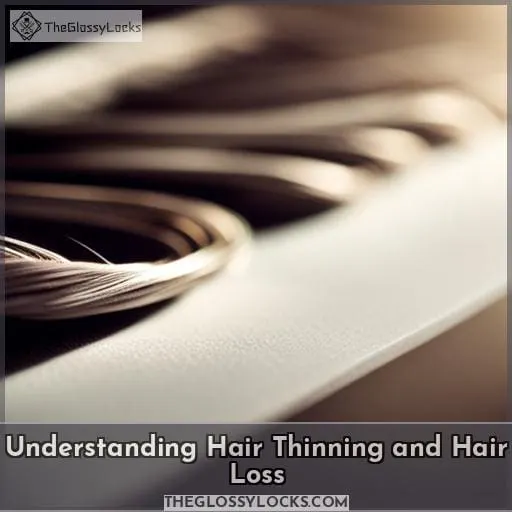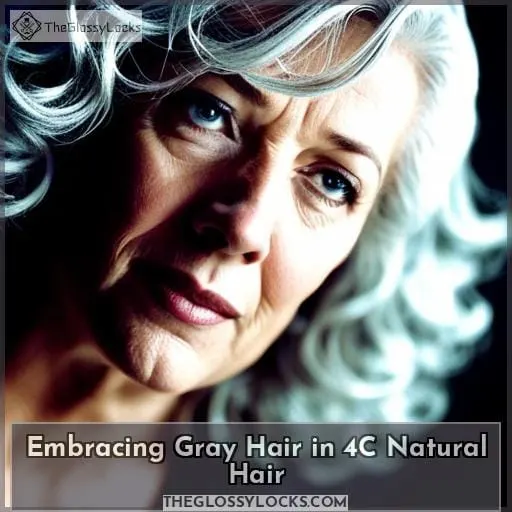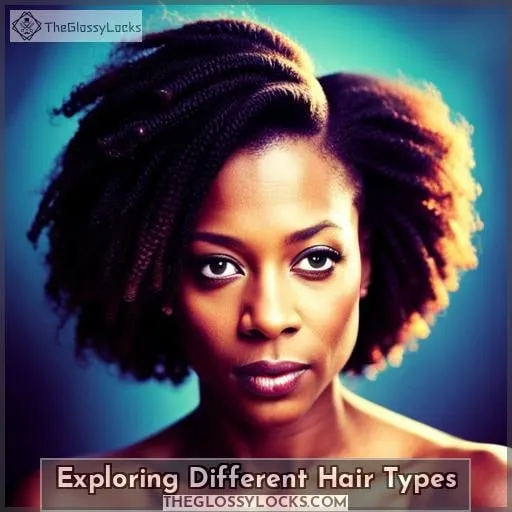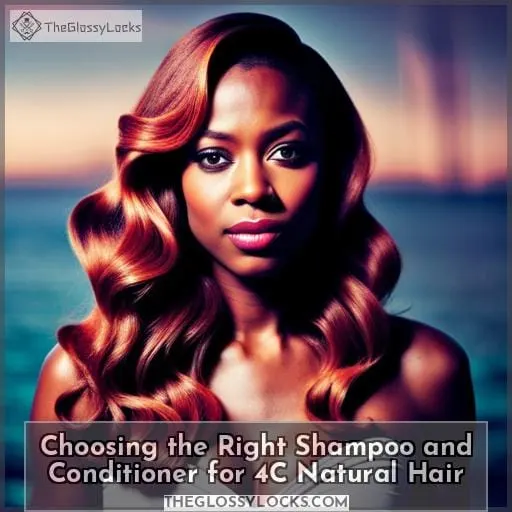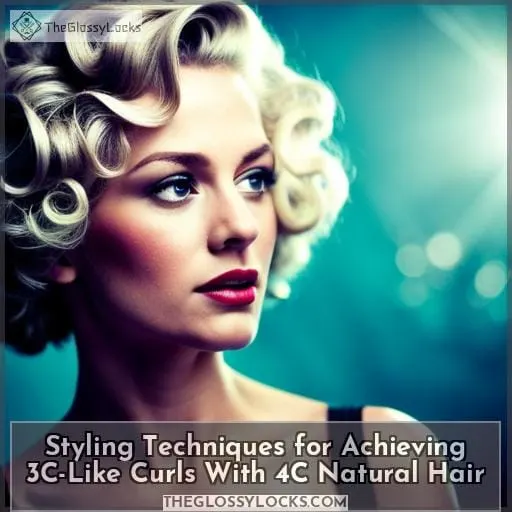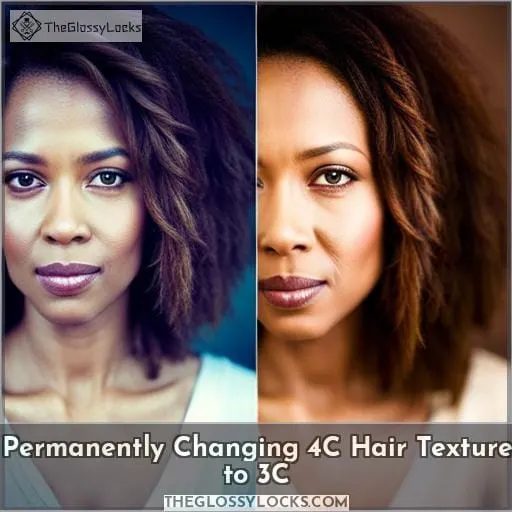This site is supported by our readers. We may earn a commission, at no cost to you, if you purchase through links.
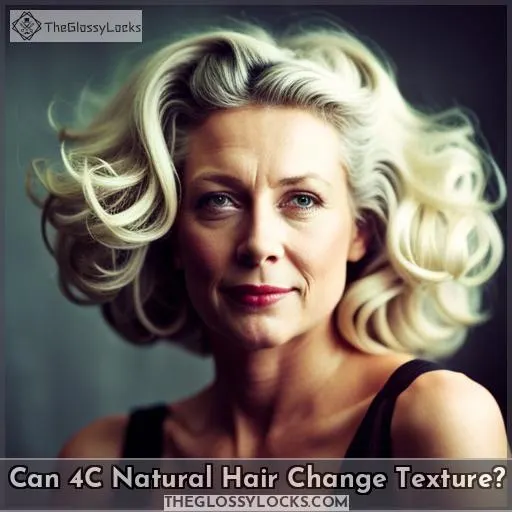
In this article, we’ll explore whether permanent changes are achievable and discuss natural ways to loosen the texture. Whether you’re seeking a new look or simply curious about the possibilities, understanding how your hair can evolve is key.
Let’s delve into the fascinating world of 4C hair and discover what transformations may lie ahead for you.
Table Of Contents
- Key Takeaways
- Can 4C Natural Hair Change Texture?
- Understanding Hair Thinning and Hair Loss
- Embracing Gray Hair in 4C Natural Hair
- Exploring Different Hair Types
- Choosing the Right Shampoo and Conditioner for 4C Natural Hair
- Styling Techniques for Achieving 3C-Like Curls With 4C Natural Hair
- Permanently Changing 4C Hair Texture to 3C
- Frequently Asked Questions (FAQs)
- How can I prevent texture changes in my 4C natural hair?
- Are there any natural remedies or treatments that can help maintain the texture of 4C hair?
- Can using certain hair products or styling techniques lead to permanent texture changes in 4C hair?
- Are there any specific vitamins or supplements that can promote healthy 4C hair texture?
- Can hormonal changes during pregnancy or menopause affect the texture of 4C natural hair?
- Conclusion
Key Takeaways
- Factors such as frequent heat styling, hormonal changes, inadequate protein in the diet, and using hard water can affect the texture of 4C natural hair.
- Permanent methods such as perms, texturizers, chemical relaxers, and keratin treatments can be used to change the texture of 4C natural hair.
- Natural ways to loosen the texture of 4C natural hair include stretching techniques, heatless styling methods, moisturizing regularly, and protecting the hair at night.
- Hair thinning and hair loss in 4C natural hair can be caused by genetics, hormonal changes, stress, and certain medical conditions. Managing and preventing hair thinning involves proper nutrition, healthy lifestyle habits, gentle handling of the hair, and a regular scalp care routine.
Can 4C Natural Hair Change Texture?
Can 4C natural hair change texture?
Understanding the factors that can affect the texture of 4C hair is important.
Factors such as frequent heat styling, hormonal changes, inadequate protein in diet, and using hard water to wash hair can all contribute to changes in hair texture.
Additionally, there are permanent methods available to change the texture of 4C natural hair, as well as non-chemical ways to temporarily alter curl patterns.
Permanently Changing 4C Hair Texture
If you’re looking to permanently change the texture of your 4C natural hair, there are several options available.
You can opt for a perm or texturizer to achieve looser curls or straighter hair.
Chemical relaxers and keratin treatments can also be used for more dramatic changes in texture.
However, it’s important to note that these methods are almost permanent and require maintenance or growing out the hair for a return to its natural 4C texture.
Natural Ways to Loosen 4C Hair Texture
To naturally loosen the texture of your 4C natural hair, you can explore various methods that promote flexibility and softness.
- Using heatless styling techniques like flexi rods or bantu knots
- Moisturizing regularly with deep conditioning treatments
- Protecting your hair at night with a satin bonnet or pillowcase
- Avoiding harsh chemicals and excessive manipulation.
By incorporating these practices into your routine, you can embrace the natural beauty of your 4C hair while promoting healthier, looser curls.
Understanding Hair Thinning and Hair Loss
Now let’s delve into the topic of understanding hair thinning and hair loss.
Hair thinning can be caused by a variety of factors, including:
- Genetics
- Hormonal changes
- Stress
- Certain medical conditions
Managing and preventing hair thinning requires a comprehensive approach that includes:
- Proper nutrition
- Healthy lifestyle habits
- Gentle handling of the hair
- Regular scalp care routine to stimulate blood circulation in the scalp area for better nutrient absorption by the follicles.
Causes of Hair Thinning and Hair Loss
As you continue to explore the topic of Can 4C Natural Hair Change Texture?, it’s important to understand the various causes of hair thinning and hair loss that can affect individuals with 4C natural hair.
Hormonal changes, such as stress, pregnancy, and menopause, can contribute to hair thinning.
Other factors include inadequate protein in the diet, using hard water for washing hair, and genetic predisposition.
Taking steps like maintaining a balanced diet and reducing stress levels can help prevent further hair loss.
| Causes of Hair Thinning | Preventing Hair Loss | Gray Hair Care |
|---|---|---|
| Hormonal changes | Maintain a balanced diet | Use products specifically |
| Inadequate protein in the diet | Reduce stress levels | formulated for gray |
Managing and Preventing Hair Thinning and Hair Loss
To effectively manage and prevent hair thinning and hair loss, it’s important to understand the causes behind these issues.
Managing thinning involves:
- Using gentle products that promote healthy hair growth.
- Avoiding excessive heat styling.
- Maintaining a balanced diet rich in nutrients for strong hair follicles.
- Reducing stress levels.
Preventing loss requires:
- Proper scalp care.
- Minimizing chemical treatments or harsh hairstyles that can cause breakage or traction alopecia.
- Regular trims to help prevent split ends and breakage.
Embracing Gray Hair in 4C Natural Hair
Embracing gray hair in 4C natural hair can be a beautiful and empowering journey. Understanding the process of hair graying and learning how to properly care for your gray strands is essential.
By embracing your natural texture, adapting your hairstyling routine, and nourishing your hair with moisture-rich products, you can confidently rock your gorgeous gray curls.
The Process of Hair Graying
Embracing gray hair in 4C natural hair is an empowering and beautiful journey.
Gray hair is a natural part of the aging process, characterized by a decrease in melanin production.
Along with these pigment changes, texture changes may also occur in 4C natural hair.
It’s important to adapt your hair care routine to embrace and maintain healthy gray strands while preserving the unique texture of your 4C curls.
Tips for Caring for Gray 4C Natural Hair
When your 4C natural hair starts to gray, it’s important to adapt your hair care routine and embrace the beauty of this natural process.
- Moisturize regularly to prevent dryness and brittleness.
- Use sulfate-free shampoos that won’t strip away moisture.
- Incorporate deep conditioning treatments into your routine to nourish the strands.
- Embrace protective styling techniques like twists or braids to minimize breakage.
Exploring Different Hair Types
Let’s explore the different hair types to better understand how 4C natural hair can change texture.
There are four main categories:
- Type 1, straight hair;
- Type 2, wavy hair;
- Type 3, curly hair;
- Type 4, coily hair.
Each type has its own unique characteristics and care needs. By understanding these distinctions, we can gain insight into the potential changes that may occur in our own natural curls (Type 4) over time.
Type 1: Straight Hair
Have you ever wondered what sets straight hair apart from other hair types?
Straight hair is characterized by its smooth and sleek appearance, with strands that lie flat against the scalp. Unlike curly or coily hair, straight hair lacks natural curl shape and tends to have a finer texture.
However, it’s important to note that not all individuals with naturally straight hair have the same texture or thickness. Hair care for straight locks typically involves minimizing damage to maintain its structure and using styling techniques like heat tools for added volume or waves if desired.
Type 2: Wavy Hair
Discover the versatile and beautiful nature of wavy hair within different hair types.
Wavy hair texture is known for its unique characteristics, such as varying degrees of curl patterns, thickness, density, porosity, and elasticity.
Understanding your wavy hair’s specific traits can help you care for it properly and achieve desired hairstyles while embracing its natural beauty without excessive heat styling or damaging techniques.
Type 3: Curly Hair
Curly hair, specifically Type 3 curls, is known for its defined and voluminous ringlets.
Hair texture changes with age can affect the appearance of Type 3 curls.
Hormones also play a role in hair texture changes, as fluctuations can alter curl pattern and definition.
Diet can impact hair health and therefore affect the texture of curly hair.
Water quality and hairstyling techniques are additional factors that can contribute to changes in Type 3 curls.
Overall, understanding these factors is crucial for maintaining healthy and vibrant curly hair.
Type 4: Coily Hair
If you’re curious about the unique characteristics of Type 4 coily hair, understanding its texture and care needs is essential.
Coily hair, also known as Type 4 hair, has a tight curl pattern that ranges from tightly coiled to densely packed coils. This type of hair tends to be fragile and prone to dryness due to its structure.
It’s important to note that while the texture may change over time or with age, proper care can help maintain healthy and defined coils.
Choosing the Right Shampoo and Conditioner for 4C Natural Hair
When it comes to choosing the right shampoo and conditioner for your 4C natural hair, there are a few factors to consider:
- For straight and wavy hair types, look for shampoos that provide gentle cleansing without weighing down the hair.
- Conditioners should focus on moisturizing and adding shine.
On the other hand, curly and coily hair types require moisture-rich shampoos that enhance curl definition while minimizing frizz.
- Conditioners should be nourishing and provide intense hydration to combat dryness in these textures.
Shampoo for Straight and Wavy Hair
When it comes to choosing the right shampoo and conditioner for your 4C natural hair, it’s important to consider not only your own unique texture but also the needs of straight and wavy hair.
- Sulfate-free shampoo: Moisturizing formula that gently cleanses without stripping natural oils.
- Clarifying shampoo: Deep-cleansing formula that removes build-up and clarifies the scalp.
- Volumizing shampoo: Lightweight formula that adds body and lift to straight or wavy hair.
- Dandruff shampoo: Clarifying formula specifically designed to treat dandruff while cleansing.
Shampoo for Curly and Coily Hair
To properly care for your 4C natural hair and maintain its texture, it’s important to choose the right shampoo and conditioner specifically designed for curly and coily hair types.
Look for sulfate-free shampoos that won’t strip away moisture from your hair.
Moisturizing shampoos can help hydrate dry strands, while clarifying shampoos remove buildup without drying out your curls.
Protein shampoos can strengthen weak or damaged hair, while volumizing shampoos add body to fine strands.
Consider using a deep conditioning mask as well to nourish and restore moisture to your 4C natural hair.
Conditioner for Straight and Wavy Hair
Looking to find the right conditioner for your straight or wavy hair? Consider these factors when choosing a conditioner:
- Look for lightweight, moisturizing formulas that won’t weigh down your hair.
- Opt for conditioners that are detangling and nourishing to keep your locks smooth and manageable.
- Choose products that offer frizz-free shine to enhance the natural beauty of your hair.
- Find conditioners specifically designed for color-treated hair to preserve vibrancy and prevent damage.
- Don’t forget affordability – look for effective options without breaking the bank.
Conditioner for Curly and Coily Hair
Choose the perfect conditioner for your curly and coily 4C natural hair to keep it moisturized and healthy.
When selecting a conditioner, look for:
- Lightweight formulas that provide intense moisture to deeply nourish your hair.
- Products that are specifically designed for detangling and fighting frizz, as these will help make styling easier.
- Conditioners with protein-rich ingredients to strengthen your strands and promote deep conditioning.
- Products that offer hold and definition while also providing shine, volume, and bounce to enhance your beautiful 4C curls.
| Conditioner Features | Product Recommendations |
|---|---|
| Lightweight Formula | Shea Moisture Jamaican Black Castor Oil Strengthen & Restore Conditioner |
| Intense Moisturization | Carol’s Daughter Almond Milk Daily Damage Repair Ultra-Nourishing Hair Mask |
| Detangling Properties | Aunt Jackie’s Knot On My Watch Instant Detangling Therapy |
| Protein-Rich Ingredients | Aphogee Curlific! Texture Treatment |
| Deep Conditioning Benefits | Cantu Argan Oil Leave-In Conditioning Repair Cream |
Styling Techniques for Achieving 3C-Like Curls With 4C Natural Hair
If you’re looking to achieve 3C-like curls with your 4C natural hair, there are several styling techniques that can help.
- Flexi rods are a great option for creating defined curls without heat.
- Bantu knots can also give you beautiful and bouncy curls when set properly.
- Using a curling wand or Curlformers can provide more uniform and long-lasting curls.
- Lastly, finger coils offer a natural way to enhance your curl pattern and create texture definition in your hair.
Flexi Rods on 4C Natural Hair
If you’re looking to achieve 3C-like curls with your 4C natural hair, you can use flexi rods.
Flexi rods are a great styling tool that can help create defined and bouncy curls without the need for heat.
To use flexi rods on 4C natural hair, start by washing and conditioning your hair.
Then, apply a leave-in conditioner or curl-enhancing product to damp hair.
Section your hair into smaller sections and wrap each section around the flexi rod from root to tip.
Allow your hair to air dry or sit under a hooded dryer for faster results.
Bantu Knots on 4C Natural Hair
To achieve 3C-like curls with your 4C natural hair, try styling it with Bantu knots.
Start by washing and conditioning your hair, then apply a leave-in conditioner or curl cream to moisturize and define your curls.
Divide your hair into small sections and twist each section tightly into a knot.
Leave the Bantu knots in for at least six hours or overnight for best results.
To maintain them, sleep with a satin bonnet or scarf to prevent frizzing.
To remove the knots, simply unravel them gently and separate the coils with your fingers for voluminous curls.
Curling Wand on 4C Natural Hair
To achieve 3C-like curls with your 4C natural hair, try using a curling wand.
When using a curling wand on 4C hair, it’s important to consider the size of the wand barrel.
- Opt for a smaller barrel size (around 1 inch) to create tighter and more defined curls.
- Adjust the temperature of the curling wand depending on your hair’s tolerance and use heat protectant spray before styling.
- Hold each section of hair around the barrel for about 10-15 seconds to ensure that curls are properly set.
- Experiment with different directions when wrapping your hair around the curling wand for more natural-looking results.
- Master different techniques like spiral wrapping or twisting sections before winding them around the iron to achieve versatile styles.
Curlformers on 4C Natural Hair
Achieve 3C-like curls with your 4C natural hair by using Curlformers.
Curlformers can be a great styling technique for those looking to achieve defined and elongated curls on their 4C hair. These innovative curlers provide a heatless and gentle way to transform your texture without causing damage.
While some people find that Curlformers hold well on their 4C hair, others may experience difficulty in getting the desired results or find them uncomfortable to sleep in overnight.
Finger Coils on 4C Natural Hair
Try finger coils to achieve 3C-like curls with your 4C natural hair.
Finger coils are a styling technique where you twist small sections of hair tightly around your fingers to create defined and elongated curls.
To achieve the best results, make sure your hair is freshly washed and moisturized.
Apply a curl-enhancing product or gel, then take small sections of hair and wrap them around your fingers from root to tip.
Allow the twists to dry completely before unraveling for beautiful coil definition that mimics 3C curls.
Maintain this style by protecting it at night with a satin scarf or bonnet, refreshing with water or leave-in conditioner as needed, and avoiding excessive manipulation that can cause frizz.
Permanently Changing 4C Hair Texture to 3C
If you’re looking to permanently change your 4C natural hair texture to a 3C curl pattern, there are a few options available.
One option is using a texturizer, which is a chemical treatment that loosens the curls and makes them more defined.
Another option is getting a curly perm, which uses chemicals to create the desired curl pattern.
It’s important to keep in mind that both of these methods involve altering the structure of your hair and require maintenance or growing out for your natural texture to return.
Using a Texturizer for 3C Curls
Now, let’s delve into the topic of permanently changing 4C hair texture to 3C curls by using a texturizer.
Texturizers are chemical treatments that can loosen tight curl patterns and create looser, more defined curls. However, it’s important to consider the pros and cons before deciding to use a texturizer.
The benefits include achieving desired curl patterns and easier manageability of hair. On the other hand, there are potential side effects such as damage to hair integrity and scalp irritation.
It’s crucial to follow instructions carefully when using a texturizer and consult with professionals for best results. Additionally, maintaining 3C curls requires proper care such as regular moisturizing routines, avoiding heat styling tools excessively.
Curly Perm for 3C Curls
To permanently change the texture of your 4C natural hair to 3C curls, consider getting a curly perm.
Here are some key points about getting a curly perm for 3C curls:
- Perm types for 3C hair: There are different types of perms available, including spiral perms and body wave perms.
- Curly perm aftercare: Proper care is essential after getting a curly perm to maintain healthy and defined curls.
- Curly perm cost, duration, and maintenance: The cost of a curly perm can vary depending on factors like salon location. The duration of the curl pattern will last until new growth appears. Regular maintenance appointments may be needed.
Frequently Asked Questions (FAQs)
How can I prevent texture changes in my 4C natural hair?
To prevent texture changes in your 4C natural hair, prioritize:
- Gentle styling methods
- Minimizing heat usage
- A healthy diet and hydration level
- Protecting your hair from harsh weather conditions
- Using products specifically formulated for your hair type
Are there any natural remedies or treatments that can help maintain the texture of 4C hair?
To maintain the texture of your 4C natural hair, you can try using natural remedies such as:
- Deep conditioning treatments with ingredients like avocado or coconut oil.
These treatments help nourish and moisturize your hair, keeping it healthy and maintaining its natural texture.
Can using certain hair products or styling techniques lead to permanent texture changes in 4C hair?
Certain hair products and styling techniques can lead to permanent texture changes in 4C natural hair.
Heat styling, chemical treatments like relaxers or perms, and frequent use of certain products may alter the curl pattern permanently.
Are there any specific vitamins or supplements that can promote healthy 4C hair texture?
To promote healthy 4C hair texture, consider incorporating vitamins and supplements into your routine.
Studies show that biotin can improve hair thickness and strength, while omega-3 fatty acids contribute to overall hair health.
Can hormonal changes during pregnancy or menopause affect the texture of 4C natural hair?
Hormonal changes during pregnancy or menopause can indeed affect the texture of 4C natural hair.
These changes may cause temporary alterations in curl pattern and overall hair structure due to fluctuations in hormone levels.
Conclusion
To conclude, it’s possible for 4C natural hair to change its texture, but permanent changes may require chemical treatments such as texturizers or curly perms.
However, there are also natural ways to loosen the texture of 4C hair, such as stretching techniques and using heatless styling methods.
Embracing the unique beauty of 4C hair is important, but it’s also exciting to explore different styles and possibilities.
So, whether you choose to embrace your natural texture or experiment with new looks, the choice is yours.

